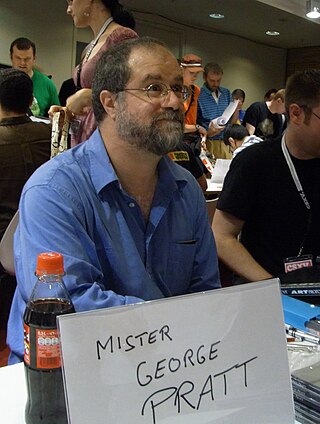Related Research Articles

The National Cartoonists Society (NCS) is an organization of professional cartoonists in the United States. It presents the National Cartoonists Society Awards. The Society was born in 1946 when groups of cartoonists got together to entertain the troops. They enjoyed each other's company and decided to meet on a regular basis.

Barbara Nessim is an American artist, illustrator, and educator.

Seymour Chwast is an American graphic designer, illustrator, and type designer.
Alan E. Cober, born in New York City was an American illustrator. His artwork appeared in The New York Times, Life, Time and numerous other publications. Cober was inducted into the Illustration Hall of Fame in 2011, thirteen years after his death in 1998. Cober was frequently cited as one of the most innovative illustrators America has ever produced.

Drew Friedman is an American cartoonist and illustrator who first gained renown for his humorous artwork and "stippling"-like style of caricature, employing thousands of pen-marks to simulate the look of a photograph. In the mid-1990s, he switched to painting.

Wanda Hazel Gág was an American artist, author, translator, and illustrator. She is best known for writing and illustrating the children's book Millions of Cats, the oldest American picture book still in print. Gág was also a noted print-maker, receiving international recognition and awards. Growing Pains, a book of excerpts from the diaries of her teen and young adult years, received widespread critical acclaim. Two of her books were awarded Newbery Honors and two received Caldecott Honors. The New York Public Library included Millions of Cats on its 2013 list of 100 Great Children's Books.

Rafał Olbinski is a Polish illustrator, painter, and educator, living in the United States. He is considered one of the major representatives of the Polish School of Posters.
Jean-Claude Suares was an artist, illustrator, editor, and creative consultant to many publications, and the first Op-Ed page art director at The New York Times.
Robert Weaver was an American illustrator who was considered a pioneer of a contemporary approach to the field that began in the 1950s.
Artists Rights Society (ARS) is a copyright, licensing, and monitoring organization for visual artists in the United States. Founded in 1987, ARS is a member of the International Confederation of Societies of Authors and Composers and as such represents in the United States the intellectual property rights interests of over 122,000 visual artists and estates of visual artists from around the world.

The Society of Illustrators (SoI) is a professional society based in New York City. It was founded in 1901 to promote the art of illustration and, since 1959, has held an annual exhibition.

Steven Heller is an American art director, journalist, critic, author, and editor who specializes in topics related to graphic design.
Steven R. Kidd, known to friends and students as Joe Kidd, was an American illustrator. He illustrated for various books and magazines and for many years was an illustrator for the New York Daily News. He taught fine art illustration at the Art Students League of New York. Kidd's illustrations also appeared in the Sunday Coloroto magazine.
Mustafa Kutlukhan Perker is a Turkish artist.

George Pratt is an American painter and illustrator known for his work in the comic book field.

The Graphic Artists Guild is a guild of graphic designers, illustrators, and photographers and is organized into seven chapters around the United States. It is a member of the international organization Icograda.
Gary Taxali is a Canadian artist that works in both fine art and illustration in the realm of pop art. He is known for his retro-inspired art and cartoon-style illustrations.
Marshall Arisman was an American illustrator, painter, storyteller, and educator.

Horacio Fidel Cardo was a painter and illustrator from Argentina.
David Suter is an American artist known for his many years producing editorial illustrations for clients such as The Washington Post, Time, and The New York Times. Known as "Suterisms" or "visual koans", his illustrations are notable for their use of bistable perception, in which Suter combines multiple images and concepts into a single image. Suter is also an accomplished fine art painter and sculptor.
References
- ↑ Holland, Brad (December 23, 2012). "The Return of Orphan Works: Trojan Horse: Orphan Works and the War on Authors". The Trichordist. Retrieved June 4, 2014.
- 1 2 3 Gallo, Irene (November 24, 2008). "Interview with Brad Holland". Tor.com . Retrieved June 4, 2014.
- ↑ A Christmas Carol. Hallmark Cards. Archived from the original on November 1, 2014. Retrieved June 4, 2014.
- 1 2 Span, Paula (1986). "A Portrait of the Star of American Illustrators". The Washington Post . Retrieved June 4, 2014.
- 1 2 "Brad Holland". Artist Profiles. October 6, 2008. Retrieved June 4, 2014.
- 1 2 Heller, Steven (2005). "Society of Illustrators Hall of Fame" . Retrieved June 4, 2014.
- ↑ "Ribald Classics". January 27, 2010. Retrieved June 4, 2014.
- 1 2 Heller, Steven (May 8, 2015). "Jean-Claude Suares, 71, a Daring Times Op-Ed Artist". The New York Times. Retrieved June 4, 2014.
- ↑ Op-Ed at 40. The New York Times. September 25, 2010. Event occurs at 2:52.
- ↑ Heller, Steven (May 15, 2014). "Taking Asylum in Cartoons". Print .
- ↑ Heller, Stephan (July 26, 2012). "The New York Review of What?". Print.
- ↑ Heller, Steven (5 August 2013). "Jean-Claude Suares, Daring Illustrator of The Times's Op-Ed Page, Dies at 71". The New York Times. Retrieved October 31, 2014.
- ↑ "Jean-Claude Suares". 2015-05-04. Retrieved June 4, 2014.
- ↑ Heller, Steven (1989). "Brad Holland".
- ↑ Kraus, Jerelle (2012-06-01). All The Art That's Fit To Print. Columbia University Press. p. 27. ISBN 978-0231138253 . Retrieved 2014-06-06.
- ↑ "Visual Metaphors Online Illustration Class".
- 1 2 Davies, Jo. "Interview with Brad Holland".
- ↑ Gordon, Michael R. (March 14, 1977). "All the Art That's Fit to Befuddle". New York : 50–. ISSN 0028-7369.
- ↑ Steven Heller. "Interview with Brad Holland". Archived from the original on 2014-07-14. Retrieved June 4, 2014.
- ↑ "ASIP Board Members" . Retrieved June 4, 2014.
- ↑ "ASIP Certificate of Incorporation" (PDF). Archived from the original (PDF) on August 13, 2014. Retrieved June 4, 2014.
- ↑ Andrew Albanese (May 8, 2013). "Publishers Weekly".
- ↑ Heller, Steven (May 10, 2011). "Illustration and the Law". Print.
- ↑ "Yaneff Artist Profile" . Retrieved 2014-06-05.
- ↑ "Orphan Works 2012 Copyright Office" . Retrieved 2014-06-03.
- ↑ "IPA reply to 2012 Copyright Office Notice of Inquiry" (PDF). Retrieved June 4, 2014.
- ↑ Chua-Eoan, Howard (5 December 2013). "The People Behind Person of the Year" . Retrieved 2014-06-05.
- ↑ "Crazy Horse Postage Stamp" . Retrieved 2014-06-05.
- ↑ "Odeon Theater Vienna Paradiso" . Retrieved 2014-06-05.
- ↑ "Serapions Fable Odeon Theater" . Retrieved 2014-06-05.
- ↑ "Brad Holland". 1 November 2014. Archived from the original on 2014-11-01.
- ↑ "Woody Pirtle per il Green Movement | SocialDesignZine". sdz.aiap.it.
- ↑ "magnifique affiche champs du possible 50x100 recto verso de 1994 (..." Skyrock.
- ↑ "AIGA Design Archives". designarchives.aiga.org.
- ↑ "La notte di Q". www.orecchioacerbo.com. 2 February 2016.
- ↑ [ dead link ]
- ↑ "Dark to Light". www.orecchioacerbo.com. 2 February 2016.
- ↑ Holland, Brad (July 1, 1996). "Express Yourself, It's Later Than You Think". The Atlantic Monthly .
- ↑ "Society of Illustrators Hall of Fame". 2015.
- ↑ "Society of Illustrators History" . Retrieved 2014-06-05.